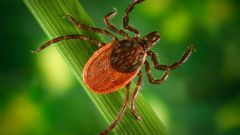To the naked eye to notice the presence of Demodex mites is impossible, since this worm is microscopic in size – from 0,1 to 0,4 mm. It can enter the skin during contact with infected person and absolutely do not disturb the medium. However, under favorable conditions often facial tick begins to actively multiply, leading to an inflammatory process in the skin - demodectic mange.
Reproduction of Demodex mites may begin with the weakening of the immune system as a result of illness, lack of certain nutrients, stress and even physical fatigue. Also, the cause may be an abrupt change in hormonal levels in humans or disruption of the normal functioning of the sebaceous glands.
During the active breeding Demodex mite emit harmful their waste products which accumulate in the upper layers of the epidermis, can cause an allergic reaction. In addition, a few weeks after the mite dies and decomposes under the skin, leading to inflammation and formation of acne.
Demodicosis outwardly resemble an allergic reaction or dermatitis, with bright redness severe. On the skin affected by this disease, you may notice a lot of pimples, rashes or acne. Common symptoms are itching and flaking. Subsequently, it may appear slight swelling, the skin becomes uneven and takes an earthy-grey tone. Affected nose may even increase slightly in size.
Often inflammatory process is exposed to the face, especially the areas near the forehead, nose and chin – that is where the person is fat skin. Less likely to suffer other areas of the head, chest and back.
Upon detection of the above signs on the skin should immediately consult a dermatologist. To diagnose subcutaneous mite is quite simple – it is enough to examine a scraping of skin under a microscope. After this the doctor will prescribe a comprehensive treatment that will focus not only on the reducing activity of the tick, but also to strengthen the immune system.
Causes of demodectic mange in people
Reproduction of Demodex mites may begin with the weakening of the immune system as a result of illness, lack of certain nutrients, stress and even physical fatigue. Also, the cause may be an abrupt change in hormonal levels in humans or disruption of the normal functioning of the sebaceous glands.
Usually Demodex mite is actively developing those who have oily prone skin. As in children the sebaceous glands are less active, the organism they are almost not affected.
Symptoms of reproduction of Demodex mites
During the active breeding Demodex mite emit harmful their waste products which accumulate in the upper layers of the epidermis, can cause an allergic reaction. In addition, a few weeks after the mite dies and decomposes under the skin, leading to inflammation and formation of acne.
Demodicosis outwardly resemble an allergic reaction or dermatitis, with bright redness severe. On the skin affected by this disease, you may notice a lot of pimples, rashes or acne. Common symptoms are itching and flaking. Subsequently, it may appear slight swelling, the skin becomes uneven and takes an earthy-grey tone. Affected nose may even increase slightly in size.
A particular danger demodicosis is for the eyes. If they are stricken with the disease, you should immediately consult a doctor, otherwise, it may decrease visual acuity.
Often inflammatory process is exposed to the face, especially the areas near the forehead, nose and chin – that is where the person is fat skin. Less likely to suffer other areas of the head, chest and back.
How to treat demodicosis
Upon detection of the above signs on the skin should immediately consult a dermatologist. To diagnose subcutaneous mite is quite simple – it is enough to examine a scraping of skin under a microscope. After this the doctor will prescribe a comprehensive treatment that will focus not only on the reducing activity of the tick, but also to strengthen the immune system.



